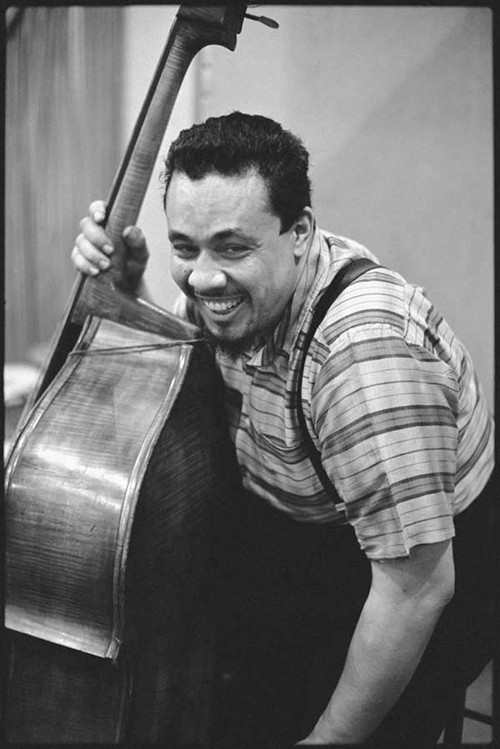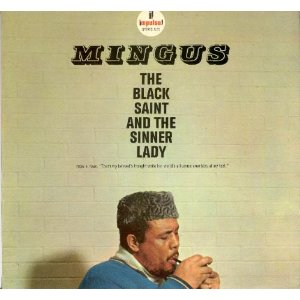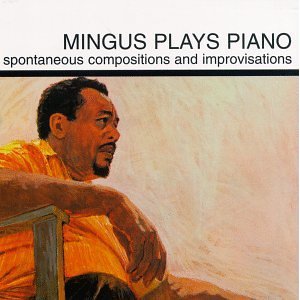CHARLES MINGUS / Mingus Mixtape #3

This is the third of a three-part consideration of the music of composer and bassist, Charles Mingus. The previous two parts are here and here.
In jazz circles Mingus is widely acknowledged as a master bass player, band leader and composer. Three of his many recordings are regularly cited as major albums in the history of jazz recordings: Tijuana Moods, Mingus Ah Um, and today’s focus, The Black Saint And The Sinner Lady.There is nothing else like Black Saint in recorded history. Hell, Mingus had his therapist, Dr. Edmund Pollock, write about Mingus as a therapy patient for the liner notes. If you Google The Black Saint and The Sinner Lady you will find oodles of accolades and effusive praise. This six part, four-track album deserves every kudo.
Indicative of Mingus’ mercurial and sometimes contradictory nature, the liner notes list six parts but there are three tracks on side one of the original LP and one track taking up the entire side two. It is impossible to break the fourth part down into three distinct parts. The Mixtape includes the entire eighteen-minute track four.
The band consists of eleven musicians who give their all in the service of this masterpiece. The personnel is: Mingus (double bass, piano), Jerome Richardson (soprano and baritone saxophone, flute), Charlie Mariano (alto saxophone), Dick Hafer (tenor saxophone, flute), Rolf Ericson (trumpet), Richard Williams (trumpet), Quentin Jackson (trombone), Don Butterfield (tuba, contrabass trombone), Jaki Byard (piano), Jay Berliner (acoustic guitar) and Dannie Richmond (drums).
You have ears, you can judge (and, more importantly, enjoy) the music yourself without the aid or hindrance of my notes, however I would like to make two meta (context, context, context) observations. First, as was normal for Mingus, somehow he is able to inspire the assembled musicians to play some of their best music on record. Lead alto saxophonist Charlie Mariano is absolutely superb. I can remember vainly trying to find other recordings that feature him blowing with the passion he exhibited on Black Saint. I never found any other recordings that even hold a candle light compared to the blow-torch intensity of Charlie’s Black Saint solos. There are many theories about how Mingus excelled as a bandleader but regardless of why or how, the solos on Mingus albums eloquently make the case: like Ellington and Miles, Mingus was able to extract massive contributions from a variety of musicians and Mariano’s incandescent alto solos are merely one set of examples. Mingus’ regular drummer Dannie Richmond did it so consistently that he is too often taken for granted but perhaps only Elvin Jones’ twinning with John Coltrane is an equally profound match of drummer and leader. In the maelstrom of this music, three bass instruments bellowing on the bottom (tuba, baritone saxophone and Mingus’ acoustic bass) or a trio of trombone and two trumpets snarling startling exclamations, it is easy to overlook both the sensitivity and the raw power of Richmond’s drumming, always offering the proper propulsion to power the music forward. The audio engineering keeps the horns in the forefront and the percussion in the background but if you listen with earphones you can hear both how nuanced and how powerful Danny Richmond’s contribution is. And I could go on describing other instrumental touches such as Jay Berliner crisp flamenco guitar passages or Jaki Byard’s short but superbly stunning piano solo. Suffice this brief review to point out that everyone who participated in this recording probably points to this work as a master achievement and perhaps even has the cover framed on their living room wall.The second meta note is simply that it is easy to overlook the intricate and dynamic arranging of this compositional masterpiece. The blowing easily bowls the listener over but both the theme and the subject matter are at an awesome level of musical portraiture. You will never forget portions of this potent music once you experience The Black Saint and The Sinner Lady.This composition is no mean feat, no easy achievement. From the enticing opening drum rhythm that introduces the thematic statement on the first track to the concluding cadenza of a lone alto wailing into what sounds like the emptiness of individual deathly diminishment disappearing into an overwhelming eternity of silence, we are presented with a musical composition that is melodically rich, harmonically daring and rhythmically overwhelming; how could one man conceive of and then lead a group of musicians to articulate this profound and audacious vision of human struggle and achievement. This is one of the most profound statements of human striving for relevance ever achieved artistically. This is the music that emphatically states: I Am.
Mingus upheld the oral tradition. He taught by ear not by reams and reams of manuscript. Throughout you can hear Mingus urging on the congregated musicians as they craft a masterpiece that is simultaneously the epitome of compositional authority mated to arrangements that are redolent in rich and intricate melding of instrumental motifs. Most startling of all is the frankly sexual nature of the music. Throughout the performance, the music has all the primal power of fucking. From moments of wistful tenderness to cathartic outbursts of collective howls, this is a frankly sexual statement unmatched by any other recording I know of. Like a major love affair this music must be experienced from beginning to end in order to be fully absorbed and appreciated. The Black Saint and The Sinner Lady: one of the true musical masterpieces of any genre or any era of recorded music. Not as an afterthought but rather as a note of personal preference I have added a fistful of tracks from Mingus’ solo piano recording Mingus Plays Piano. I’ve always been smitten by the emotional vulnerability of that recording. Mingus is no virtuoso in terms of raw technique but in terms of nakedly expressing his visceral emotions, this recording excels. The listener can both be impressed with the structure of the solos as Mingus develops thematic statements and simultaneously touched by the bold display of emotions inherent in Mingus’ expressive touch on the piano keys. Here is profound passion without the pretense of romance. Think of Mingus Plays Piano as a final sip of wine after the feast of the musical banquet that is The Black Saint and The Sinner Lady. —Kalamu ya Salaam Mingus Mixtape #3 Playlist The Black Saint and The Sinner Lady
01 "Trio and Group Dancers"
The Black Saint and The Sinner Lady
01 "Trio and Group Dancers"

02 “Myself When I Am Real”
03 “I Can't Get Started”
04 “Roland Kirk's Message”05 “Orange Was the Color of Her Dress, Then Silk Blues”
06 “Compositional Theme Story: Medleys, Anthems and Folklore”
This entry was posted on Monday, June 25th, 2012 at 2:18 pm and is filed under Classic. You can follow any responses to this entry through the RSS 2.0 feed. You can leave a response, or trackback from your own site.
2 Responses to “CHARLES MINGUS / Mingus Mixtape #3”
July 13th, 2012 at 11:47 pm
this is seriously wonderful music to listen to. thanks for sharing!
July 14th, 2012 at 10:09 pm
Big thanks Kalamu for shining more light on this brilliant music — and brilliant musician. And for turning me on to his piano work, which I’d previously overlooked.
Blessings and best wishes!
Leave a Reply
| top |